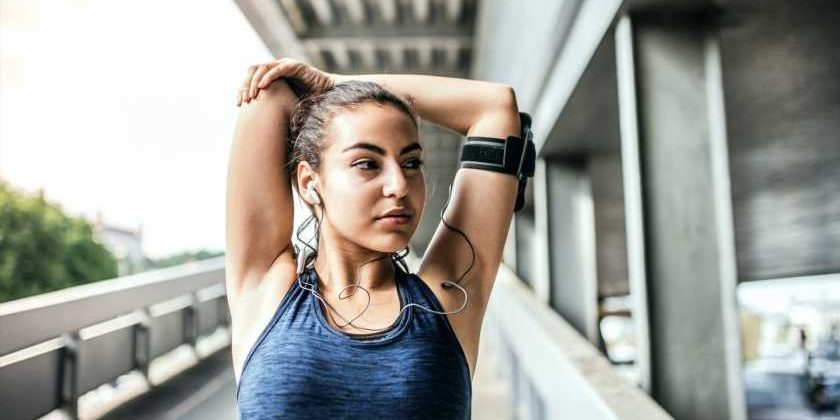Want to run a faster 5k? You’re going to have to strengthen more than just your legs. We speak to the experts on the role that arms play in running fast.
To run, you need three things: strong glutes, a decent diet and a good dose of determination. Don’t fuel adequately and you won’t make it past the end of the road. You need grit to get past the front door at all, while strong, balanced glutes will protect against knee pain, back pain and twisted ankles.
But to run faster and stronger, you need to be strong everywhere. It’s not good enough simply to have strong legs; a weak core can lead to a sore back. But what about arms and shoulders? Do runners really need to add an upper body gym session to their training?
You may also like
Running tips: 4 ways strength training makes you a better, faster runner
Different running goals need different types of training. If you’re a sprinter, for example, your arms might work hard to help you move at speed through the air. Those of us who run slower and longer, however, probably haven’t got a clue what our arms are doing when we head out for a jog.
The benefits of having strong arms for running have long been known; in fact, even the Greek philosopher Aristotle is said to have written that runners can “run faster if they swing their arms”. When you watch sprinters compete, they tend to have really muscular arms and shoulders, suggesting too that there’s some benefit to being able to cut your way through the air.
A new study, however, has actually suggested that arms might not be as important as we think. Seventeen athletes were made to sprint, either with their arms crossed over their chests, or actively swinging. While athletes sprinted faster when their arms were swinging as usual, it was only by the smallest of margins (0.10 seconds on average).
The paper’s authors say that when arm motion is restricted, alternative upper body movement proves the rotational forces needed to offset the momentum generated by swinging legs. That’s led them to conclude “that restricting arm motion compromised short sprint running performance, but only marginally”.

That makes it sound like arms don’t make much difference when it comes to running performance – and certainly would suggest that you don’t need to specifically train the upper body to run faster, right?
Well, as ever, it’s not that simple. First off, the study involved a handful of people sprinting 30m at a timel; unless you’re part of a sprint squad, that’s relatively useless. Your local Parkrun course is 166 times longer.
And then there’s the fact that loads of other studies have proved just how important using your arms is in running, like a paper from 2021 which looked at the role of the biceps and traps (shoulders) in running. It found that there’s a neuromechanical connection between the shoulders and bicep muscles when we run, and that that link isn’t so evident when we walk. And that suggests that strengthening those muscles could benefit how well we run.
Run coaches believe that strong arms are crucial to good running posture
Even anecdotally, whenever I’m coming towards the end of an event and my legs are tired, I use my arms more than ever to help propel me forward.
It’s for that reason that licensed England Athletics coach Kate Carter believes that running is “a bit of a workout for your arms(if you are actually using them properly). For thatreason, she says that you “probably don’t desperately need to do extra [upper body training] if you run longer distances”.
However, she’s also keen to stress that building whole body strength is going to help with maintaining good running form when we start to get tired.
“For really fast running – sprinting – the arms become even more significant, so it’s definitely important for them to be strong.
“Generally speaking, I do a bit of upper body work in my S&C workouts anyway just for balance.” And Carter is the world’s fastest panda, so she knows a thing or two.
Which arm exercises should you try to help run a faster 5k?
Dora Atim, Nike Run coach and previous Strong Women cover star, is a huge advocate for training the upper body to run stronger. “We want to think about creating strong foundations for running,” she explains, “in order to minimise the energy expenditure as much as we can.” That means training the arms to make life easier for the legs.
“When you think about it, running is basically hopping on one leg for a long time, so the arms actually counterbalance this movement and help improve your overall running rhythm.” She’s keen to stress that it doesn’t have to be overly complicated – think about adding pushups, planks, tricep dips and bicep curls to your cross training routine.
“As a coach, I always tell runners to really focus on training the whole body and not to neglect the upper muscles. I often run super long distances, including the marathon, and when my body feels tired, my strong arms allow me to maintain form for as long as possible and keep up the tempo that I am running,” she tells Stylist.
“That means pumping my arms fast in order to run quicker. I’m using my arms to help my body glide through the many miles, like an efficient, well-oiled machine.”
So that study may have found no real distance over a minuscule distance, but to the women who run regular distances, training the upper body matters. As Atim concludes: “Strong arms, a strong core and strong shoulders will equal a strong runner, and a strong runner is one who can improve their performance and runs forever.”
Images: Getty
Source: Read Full Article
